Impact of Digitalization on Education
VerifiedAdded on 2020/06/06
|13
|4628
|87
AI Summary
This assignment analyzes the profound influence of digitalization on the field of education. It examines how technology is transforming teaching methods, creating innovative learning experiences, and shaping the future of educational practices. The analysis delves into various aspects, such as flipped classrooms, active learning strategies, online repositories for physical samples, and the integration of robotics in education.
Contribute Materials
Your contribution can guide someone’s learning journey. Share your
documents today.
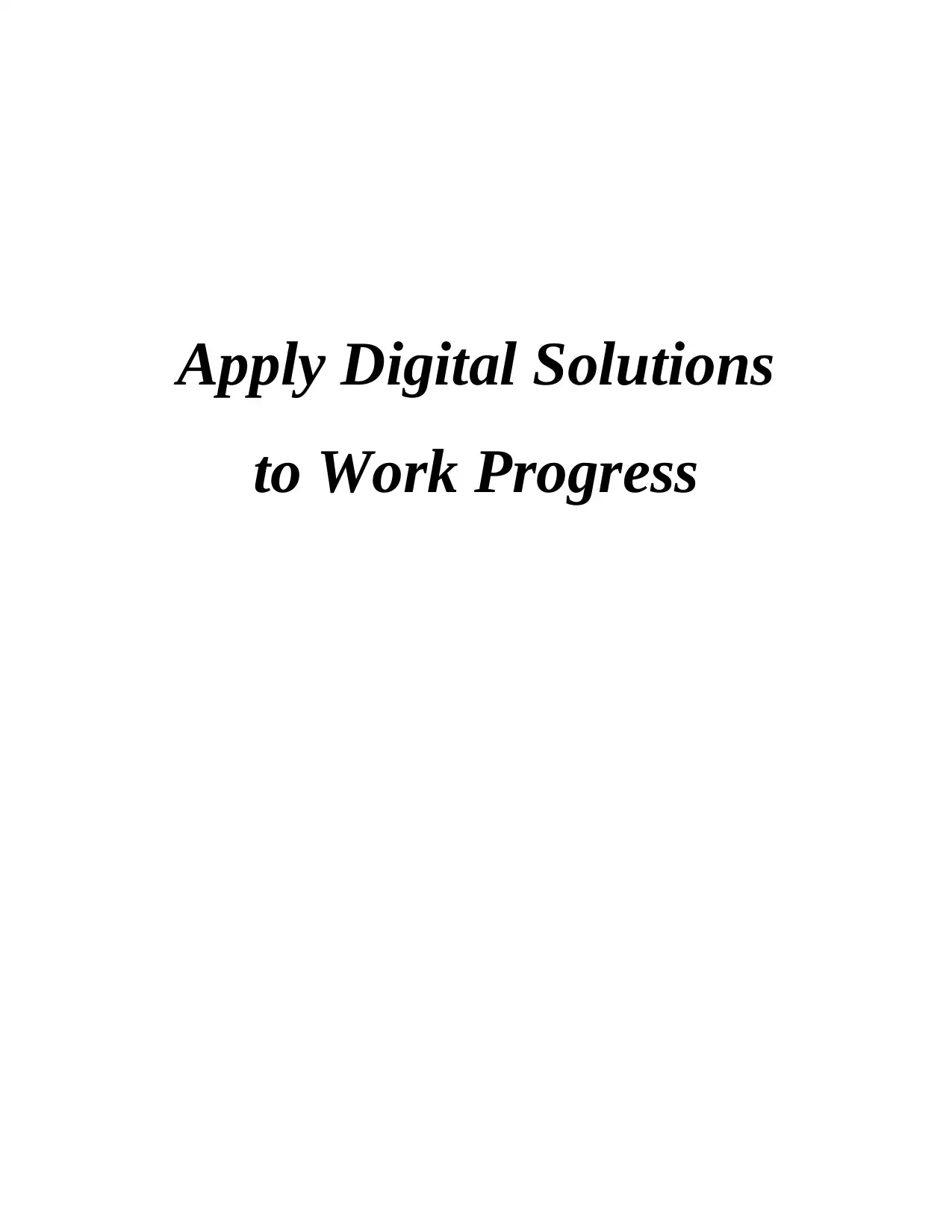
Apply Digital Solutions
to Work Progress
to Work Progress
Secure Best Marks with AI Grader
Need help grading? Try our AI Grader for instant feedback on your assignments.
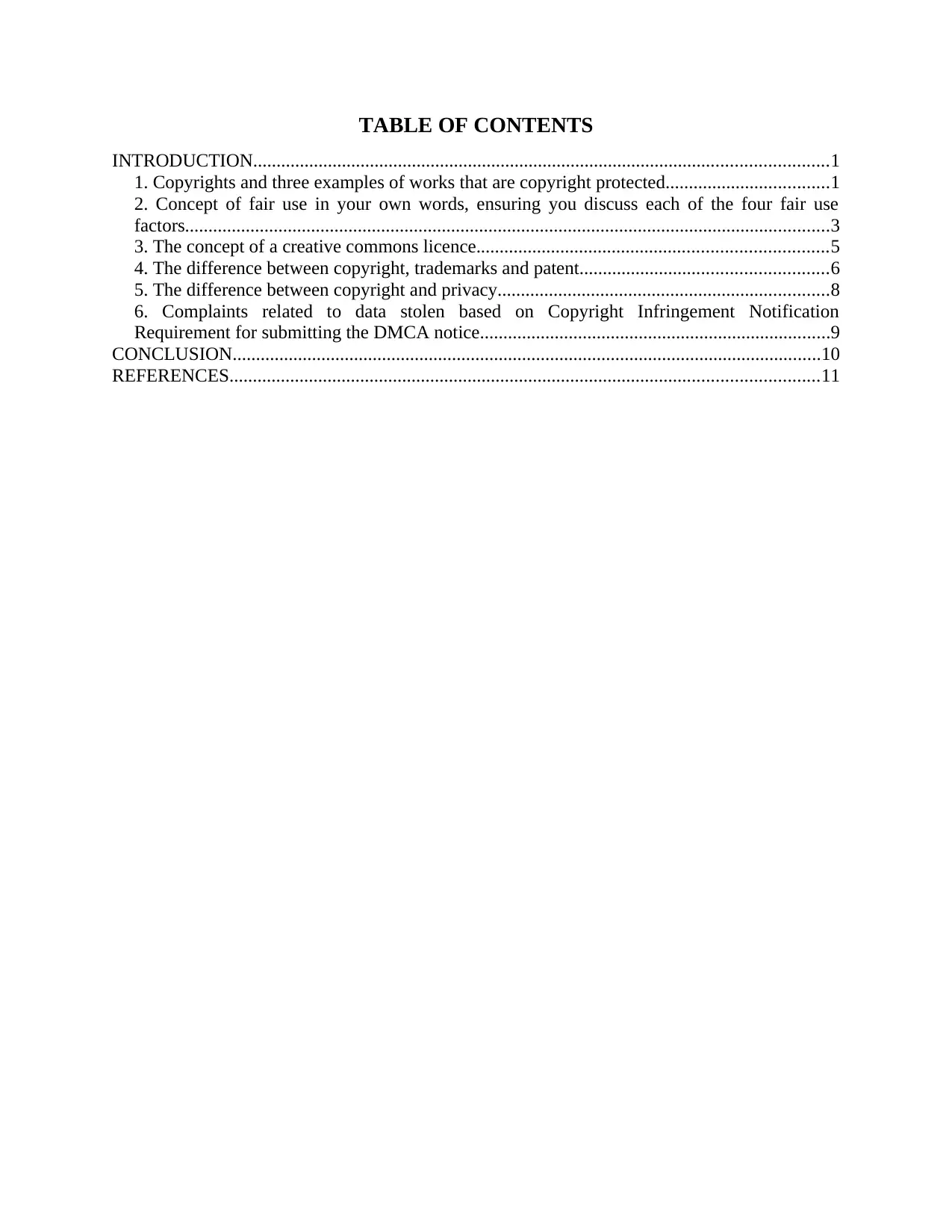
TABLE OF CONTENTS
INTRODUCTION...........................................................................................................................1
1. Copyrights and three examples of works that are copyright protected...................................1
2. Concept of fair use in your own words, ensuring you discuss each of the four fair use
factors..........................................................................................................................................3
3. The concept of a creative commons licence...........................................................................5
4. The difference between copyright, trademarks and patent.....................................................6
5. The difference between copyright and privacy.......................................................................8
6. Complaints related to data stolen based on Copyright Infringement Notification
Requirement for submitting the DMCA notice...........................................................................9
CONCLUSION..............................................................................................................................10
REFERENCES..............................................................................................................................11
INTRODUCTION...........................................................................................................................1
1. Copyrights and three examples of works that are copyright protected...................................1
2. Concept of fair use in your own words, ensuring you discuss each of the four fair use
factors..........................................................................................................................................3
3. The concept of a creative commons licence...........................................................................5
4. The difference between copyright, trademarks and patent.....................................................6
5. The difference between copyright and privacy.......................................................................8
6. Complaints related to data stolen based on Copyright Infringement Notification
Requirement for submitting the DMCA notice...........................................................................9
CONCLUSION..............................................................................................................................10
REFERENCES..............................................................................................................................11
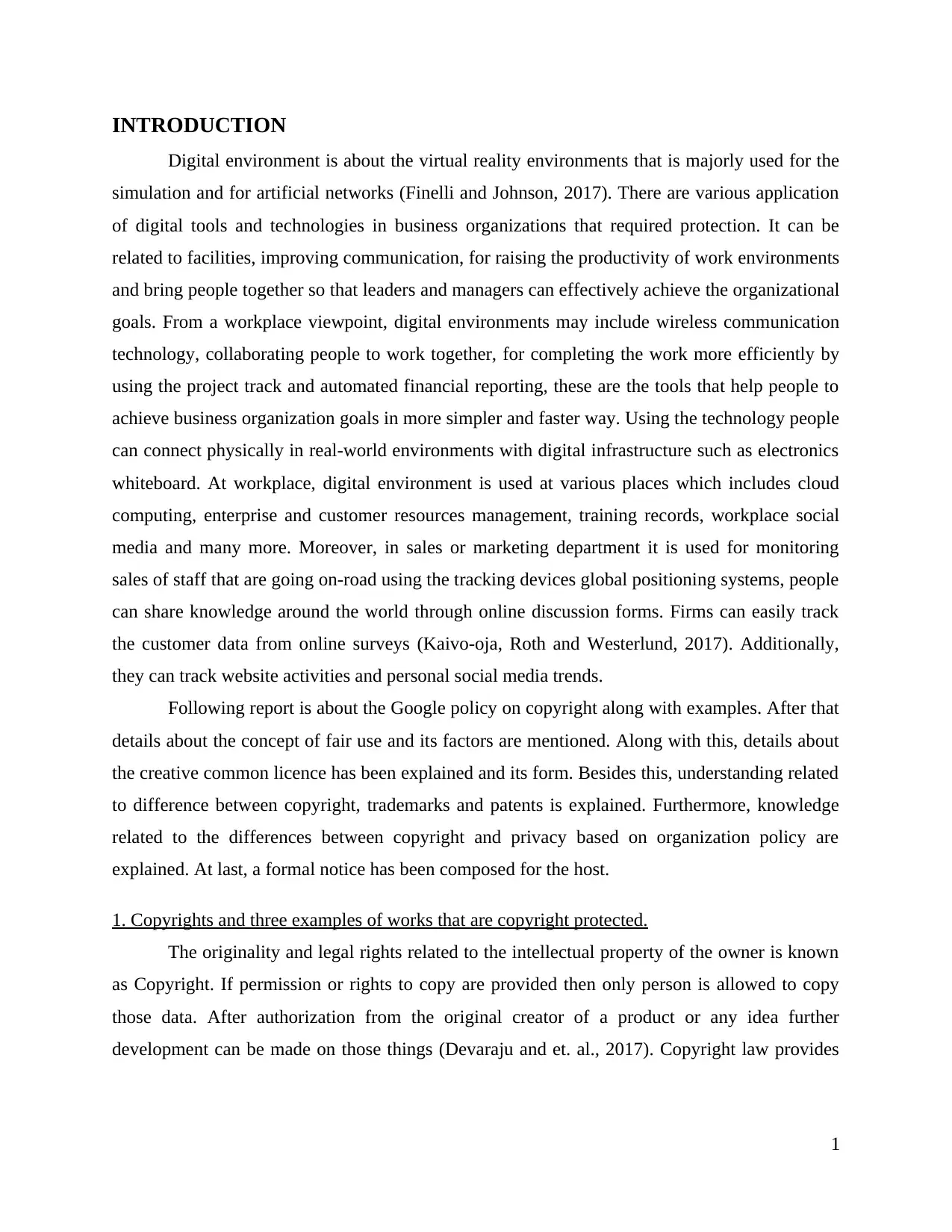
INTRODUCTION
Digital environment is about the virtual reality environments that is majorly used for the
simulation and for artificial networks (Finelli and Johnson, 2017). There are various application
of digital tools and technologies in business organizations that required protection. It can be
related to facilities, improving communication, for raising the productivity of work environments
and bring people together so that leaders and managers can effectively achieve the organizational
goals. From a workplace viewpoint, digital environments may include wireless communication
technology, collaborating people to work together, for completing the work more efficiently by
using the project track and automated financial reporting, these are the tools that help people to
achieve business organization goals in more simpler and faster way. Using the technology people
can connect physically in real-world environments with digital infrastructure such as electronics
whiteboard. At workplace, digital environment is used at various places which includes cloud
computing, enterprise and customer resources management, training records, workplace social
media and many more. Moreover, in sales or marketing department it is used for monitoring
sales of staff that are going on-road using the tracking devices global positioning systems, people
can share knowledge around the world through online discussion forms. Firms can easily track
the customer data from online surveys (Kaivo-oja, Roth and Westerlund, 2017). Additionally,
they can track website activities and personal social media trends.
Following report is about the Google policy on copyright along with examples. After that
details about the concept of fair use and its factors are mentioned. Along with this, details about
the creative common licence has been explained and its form. Besides this, understanding related
to difference between copyright, trademarks and patents is explained. Furthermore, knowledge
related to the differences between copyright and privacy based on organization policy are
explained. At last, a formal notice has been composed for the host.
1. Copyrights and three examples of works that are copyright protected.
The originality and legal rights related to the intellectual property of the owner is known
as Copyright. If permission or rights to copy are provided then only person is allowed to copy
those data. After authorization from the original creator of a product or any idea further
development can be made on those things (Devaraju and et. al., 2017). Copyright law provides
1
Digital environment is about the virtual reality environments that is majorly used for the
simulation and for artificial networks (Finelli and Johnson, 2017). There are various application
of digital tools and technologies in business organizations that required protection. It can be
related to facilities, improving communication, for raising the productivity of work environments
and bring people together so that leaders and managers can effectively achieve the organizational
goals. From a workplace viewpoint, digital environments may include wireless communication
technology, collaborating people to work together, for completing the work more efficiently by
using the project track and automated financial reporting, these are the tools that help people to
achieve business organization goals in more simpler and faster way. Using the technology people
can connect physically in real-world environments with digital infrastructure such as electronics
whiteboard. At workplace, digital environment is used at various places which includes cloud
computing, enterprise and customer resources management, training records, workplace social
media and many more. Moreover, in sales or marketing department it is used for monitoring
sales of staff that are going on-road using the tracking devices global positioning systems, people
can share knowledge around the world through online discussion forms. Firms can easily track
the customer data from online surveys (Kaivo-oja, Roth and Westerlund, 2017). Additionally,
they can track website activities and personal social media trends.
Following report is about the Google policy on copyright along with examples. After that
details about the concept of fair use and its factors are mentioned. Along with this, details about
the creative common licence has been explained and its form. Besides this, understanding related
to difference between copyright, trademarks and patents is explained. Furthermore, knowledge
related to the differences between copyright and privacy based on organization policy are
explained. At last, a formal notice has been composed for the host.
1. Copyrights and three examples of works that are copyright protected.
The originality and legal rights related to the intellectual property of the owner is known
as Copyright. If permission or rights to copy are provided then only person is allowed to copy
those data. After authorization from the original creator of a product or any idea further
development can be made on those things (Devaraju and et. al., 2017). Copyright law provides
1
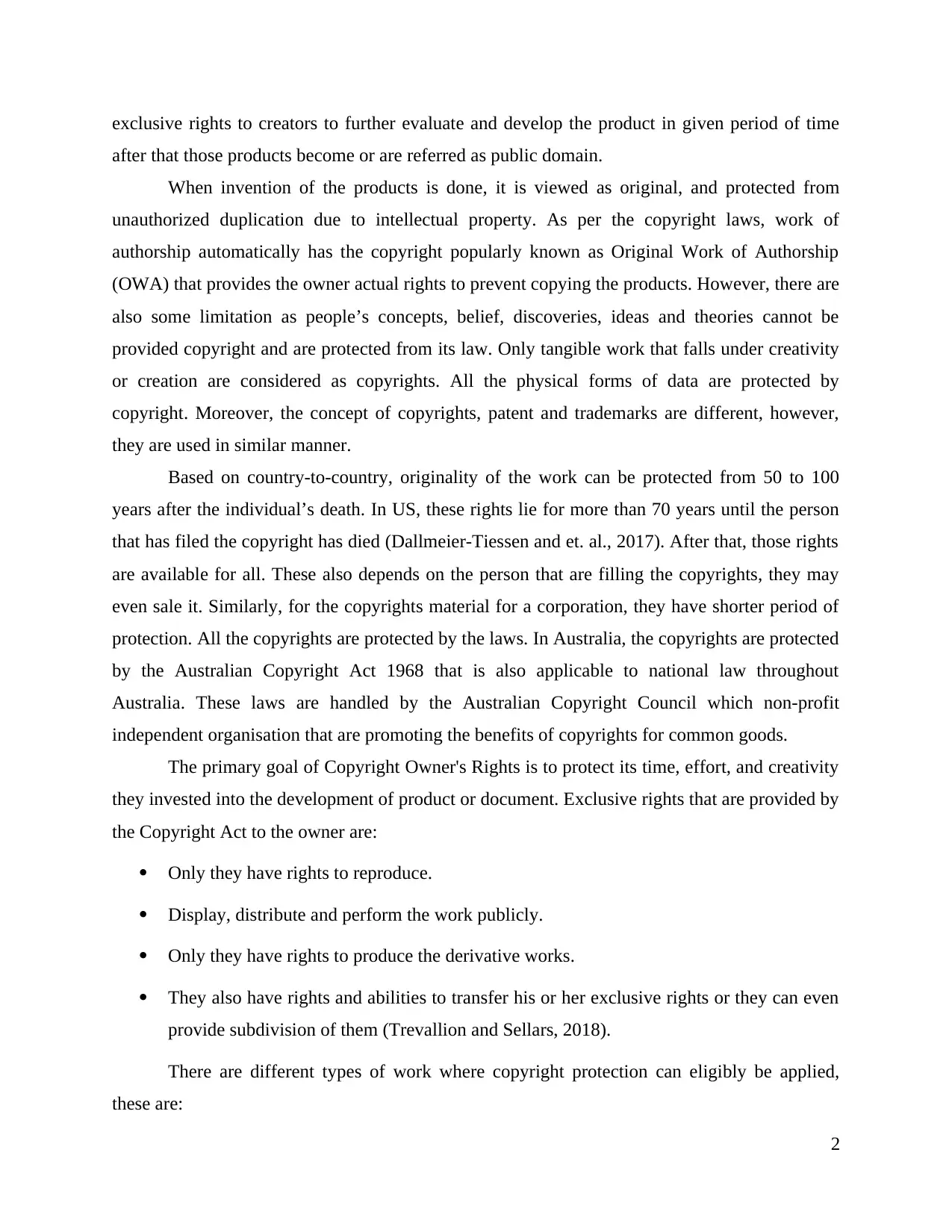
exclusive rights to creators to further evaluate and develop the product in given period of time
after that those products become or are referred as public domain.
When invention of the products is done, it is viewed as original, and protected from
unauthorized duplication due to intellectual property. As per the copyright laws, work of
authorship automatically has the copyright popularly known as Original Work of Authorship
(OWA) that provides the owner actual rights to prevent copying the products. However, there are
also some limitation as people’s concepts, belief, discoveries, ideas and theories cannot be
provided copyright and are protected from its law. Only tangible work that falls under creativity
or creation are considered as copyrights. All the physical forms of data are protected by
copyright. Moreover, the concept of copyrights, patent and trademarks are different, however,
they are used in similar manner.
Based on country-to-country, originality of the work can be protected from 50 to 100
years after the individual’s death. In US, these rights lie for more than 70 years until the person
that has filed the copyright has died (Dallmeier-Tiessen and et. al., 2017). After that, those rights
are available for all. These also depends on the person that are filling the copyrights, they may
even sale it. Similarly, for the copyrights material for a corporation, they have shorter period of
protection. All the copyrights are protected by the laws. In Australia, the copyrights are protected
by the Australian Copyright Act 1968 that is also applicable to national law throughout
Australia. These laws are handled by the Australian Copyright Council which non-profit
independent organisation that are promoting the benefits of copyrights for common goods.
The primary goal of Copyright Owner's Rights is to protect its time, effort, and creativity
they invested into the development of product or document. Exclusive rights that are provided by
the Copyright Act to the owner are:
Only they have rights to reproduce.
Display, distribute and perform the work publicly.
Only they have rights to produce the derivative works.
They also have rights and abilities to transfer his or her exclusive rights or they can even
provide subdivision of them (Trevallion and Sellars, 2018).
There are different types of work where copyright protection can eligibly be applied,
these are:
2
after that those products become or are referred as public domain.
When invention of the products is done, it is viewed as original, and protected from
unauthorized duplication due to intellectual property. As per the copyright laws, work of
authorship automatically has the copyright popularly known as Original Work of Authorship
(OWA) that provides the owner actual rights to prevent copying the products. However, there are
also some limitation as people’s concepts, belief, discoveries, ideas and theories cannot be
provided copyright and are protected from its law. Only tangible work that falls under creativity
or creation are considered as copyrights. All the physical forms of data are protected by
copyright. Moreover, the concept of copyrights, patent and trademarks are different, however,
they are used in similar manner.
Based on country-to-country, originality of the work can be protected from 50 to 100
years after the individual’s death. In US, these rights lie for more than 70 years until the person
that has filed the copyright has died (Dallmeier-Tiessen and et. al., 2017). After that, those rights
are available for all. These also depends on the person that are filling the copyrights, they may
even sale it. Similarly, for the copyrights material for a corporation, they have shorter period of
protection. All the copyrights are protected by the laws. In Australia, the copyrights are protected
by the Australian Copyright Act 1968 that is also applicable to national law throughout
Australia. These laws are handled by the Australian Copyright Council which non-profit
independent organisation that are promoting the benefits of copyrights for common goods.
The primary goal of Copyright Owner's Rights is to protect its time, effort, and creativity
they invested into the development of product or document. Exclusive rights that are provided by
the Copyright Act to the owner are:
Only they have rights to reproduce.
Display, distribute and perform the work publicly.
Only they have rights to produce the derivative works.
They also have rights and abilities to transfer his or her exclusive rights or they can even
provide subdivision of them (Trevallion and Sellars, 2018).
There are different types of work where copyright protection can eligibly be applied,
these are:
2
Secure Best Marks with AI Grader
Need help grading? Try our AI Grader for instant feedback on your assignments.
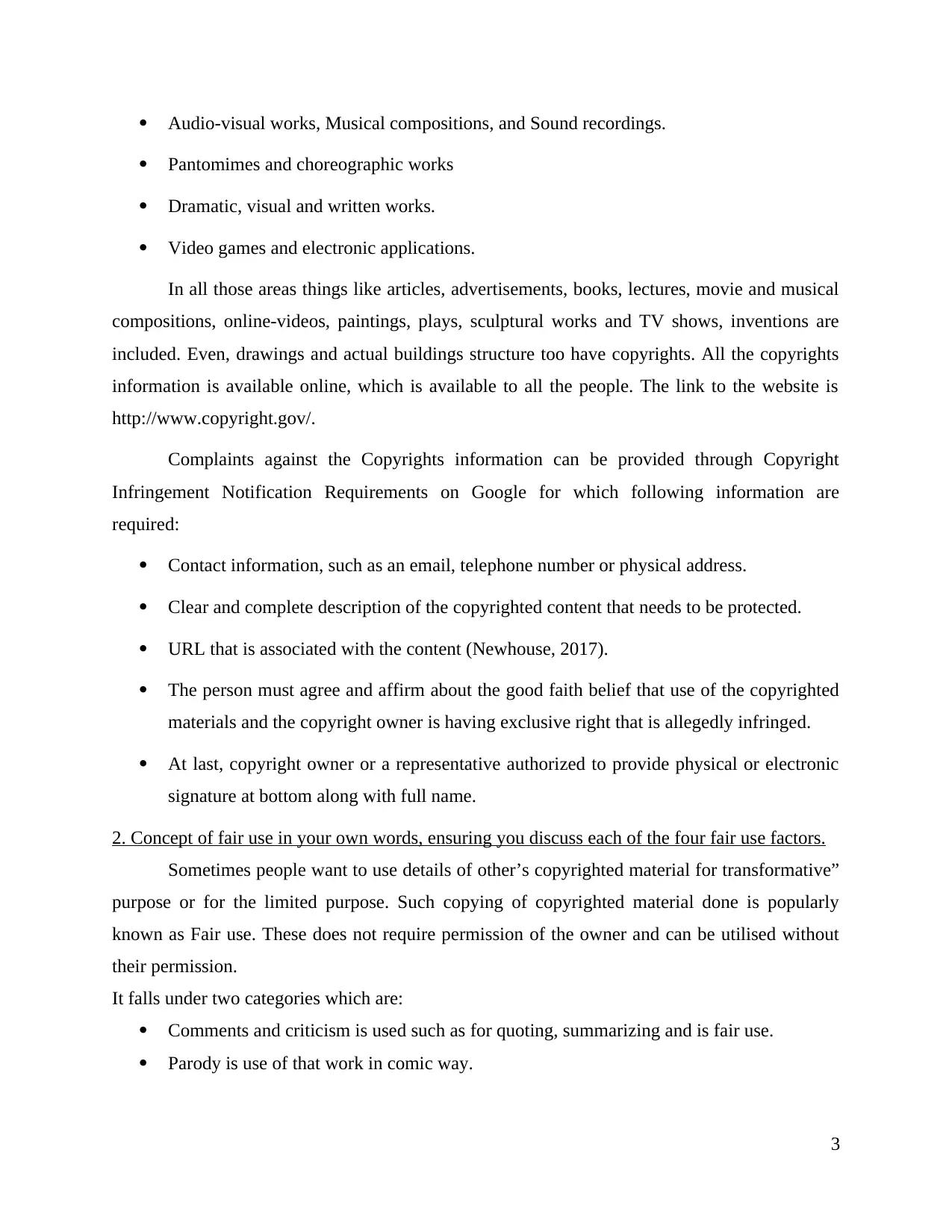
Audio-visual works, Musical compositions, and Sound recordings.
Pantomimes and choreographic works
Dramatic, visual and written works.
Video games and electronic applications.
In all those areas things like articles, advertisements, books, lectures, movie and musical
compositions, online-videos, paintings, plays, sculptural works and TV shows, inventions are
included. Even, drawings and actual buildings structure too have copyrights. All the copyrights
information is available online, which is available to all the people. The link to the website is
http://www.copyright.gov/.
Complaints against the Copyrights information can be provided through Copyright
Infringement Notification Requirements on Google for which following information are
required:
Contact information, such as an email, telephone number or physical address.
Clear and complete description of the copyrighted content that needs to be protected.
URL that is associated with the content (Newhouse, 2017).
The person must agree and affirm about the good faith belief that use of the copyrighted
materials and the copyright owner is having exclusive right that is allegedly infringed.
At last, copyright owner or a representative authorized to provide physical or electronic
signature at bottom along with full name.
2. Concept of fair use in your own words, ensuring you discuss each of the four fair use factors.
Sometimes people want to use details of other’s copyrighted material for transformative”
purpose or for the limited purpose. Such copying of copyrighted material done is popularly
known as Fair use. These does not require permission of the owner and can be utilised without
their permission.
It falls under two categories which are:
Comments and criticism is used such as for quoting, summarizing and is fair use.
Parody is use of that work in comic way.
3
Pantomimes and choreographic works
Dramatic, visual and written works.
Video games and electronic applications.
In all those areas things like articles, advertisements, books, lectures, movie and musical
compositions, online-videos, paintings, plays, sculptural works and TV shows, inventions are
included. Even, drawings and actual buildings structure too have copyrights. All the copyrights
information is available online, which is available to all the people. The link to the website is
http://www.copyright.gov/.
Complaints against the Copyrights information can be provided through Copyright
Infringement Notification Requirements on Google for which following information are
required:
Contact information, such as an email, telephone number or physical address.
Clear and complete description of the copyrighted content that needs to be protected.
URL that is associated with the content (Newhouse, 2017).
The person must agree and affirm about the good faith belief that use of the copyrighted
materials and the copyright owner is having exclusive right that is allegedly infringed.
At last, copyright owner or a representative authorized to provide physical or electronic
signature at bottom along with full name.
2. Concept of fair use in your own words, ensuring you discuss each of the four fair use factors.
Sometimes people want to use details of other’s copyrighted material for transformative”
purpose or for the limited purpose. Such copying of copyrighted material done is popularly
known as Fair use. These does not require permission of the owner and can be utilised without
their permission.
It falls under two categories which are:
Comments and criticism is used such as for quoting, summarizing and is fair use.
Parody is use of that work in comic way.
3
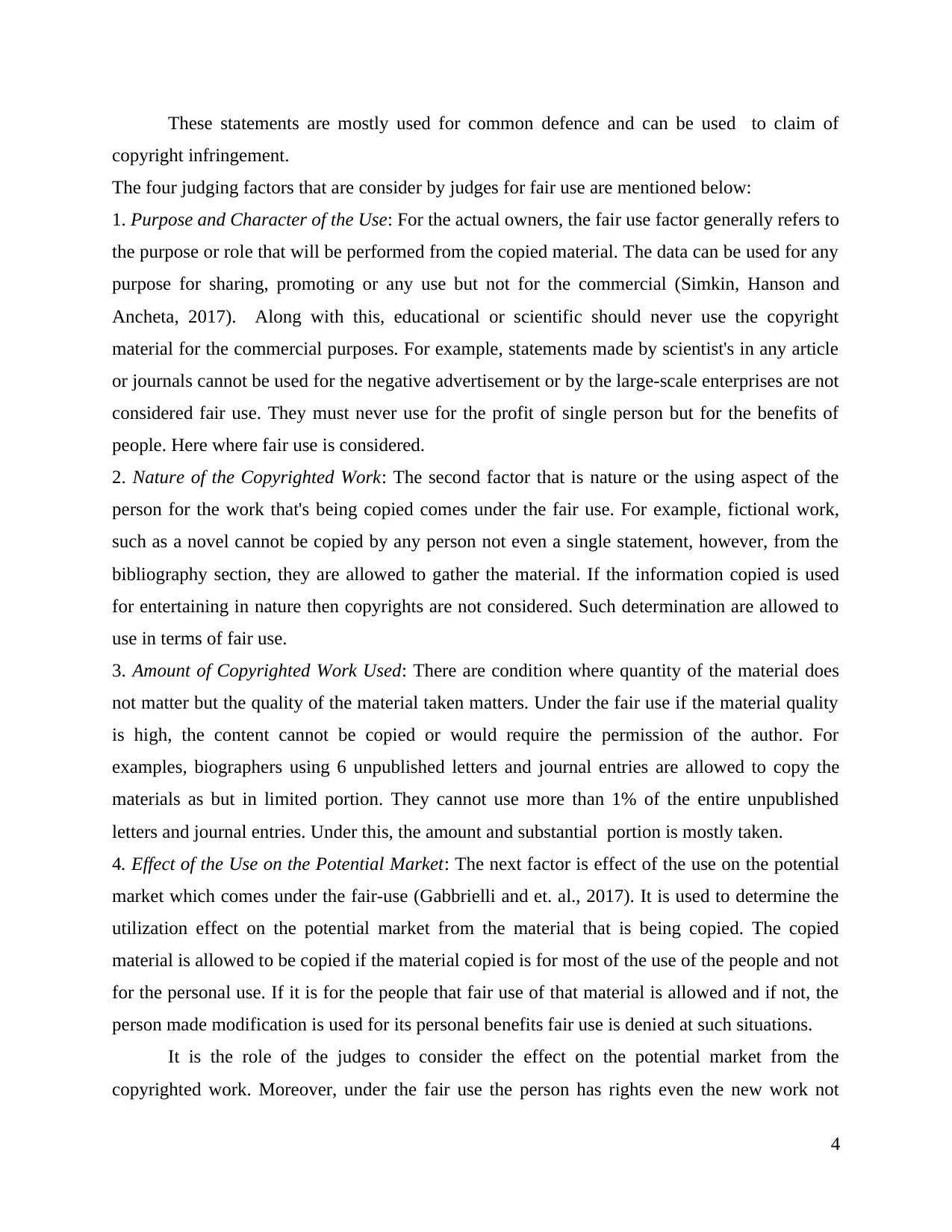
These statements are mostly used for common defence and can be used to claim of
copyright infringement.
The four judging factors that are consider by judges for fair use are mentioned below:
1. Purpose and Character of the Use: For the actual owners, the fair use factor generally refers to
the purpose or role that will be performed from the copied material. The data can be used for any
purpose for sharing, promoting or any use but not for the commercial (Simkin, Hanson and
Ancheta, 2017). Along with this, educational or scientific should never use the copyright
material for the commercial purposes. For example, statements made by scientist's in any article
or journals cannot be used for the negative advertisement or by the large-scale enterprises are not
considered fair use. They must never use for the profit of single person but for the benefits of
people. Here where fair use is considered.
2. Nature of the Copyrighted Work: The second factor that is nature or the using aspect of the
person for the work that's being copied comes under the fair use. For example, fictional work,
such as a novel cannot be copied by any person not even a single statement, however, from the
bibliography section, they are allowed to gather the material. If the information copied is used
for entertaining in nature then copyrights are not considered. Such determination are allowed to
use in terms of fair use.
3. Amount of Copyrighted Work Used: There are condition where quantity of the material does
not matter but the quality of the material taken matters. Under the fair use if the material quality
is high, the content cannot be copied or would require the permission of the author. For
examples, biographers using 6 unpublished letters and journal entries are allowed to copy the
materials as but in limited portion. They cannot use more than 1% of the entire unpublished
letters and journal entries. Under this, the amount and substantial portion is mostly taken.
4. Effect of the Use on the Potential Market: The next factor is effect of the use on the potential
market which comes under the fair-use (Gabbrielli and et. al., 2017). It is used to determine the
utilization effect on the potential market from the material that is being copied. The copied
material is allowed to be copied if the material copied is for most of the use of the people and not
for the personal use. If it is for the people that fair use of that material is allowed and if not, the
person made modification is used for its personal benefits fair use is denied at such situations.
It is the role of the judges to consider the effect on the potential market from the
copyrighted work. Moreover, under the fair use the person has rights even the new work not
4
copyright infringement.
The four judging factors that are consider by judges for fair use are mentioned below:
1. Purpose and Character of the Use: For the actual owners, the fair use factor generally refers to
the purpose or role that will be performed from the copied material. The data can be used for any
purpose for sharing, promoting or any use but not for the commercial (Simkin, Hanson and
Ancheta, 2017). Along with this, educational or scientific should never use the copyright
material for the commercial purposes. For example, statements made by scientist's in any article
or journals cannot be used for the negative advertisement or by the large-scale enterprises are not
considered fair use. They must never use for the profit of single person but for the benefits of
people. Here where fair use is considered.
2. Nature of the Copyrighted Work: The second factor that is nature or the using aspect of the
person for the work that's being copied comes under the fair use. For example, fictional work,
such as a novel cannot be copied by any person not even a single statement, however, from the
bibliography section, they are allowed to gather the material. If the information copied is used
for entertaining in nature then copyrights are not considered. Such determination are allowed to
use in terms of fair use.
3. Amount of Copyrighted Work Used: There are condition where quantity of the material does
not matter but the quality of the material taken matters. Under the fair use if the material quality
is high, the content cannot be copied or would require the permission of the author. For
examples, biographers using 6 unpublished letters and journal entries are allowed to copy the
materials as but in limited portion. They cannot use more than 1% of the entire unpublished
letters and journal entries. Under this, the amount and substantial portion is mostly taken.
4. Effect of the Use on the Potential Market: The next factor is effect of the use on the potential
market which comes under the fair-use (Gabbrielli and et. al., 2017). It is used to determine the
utilization effect on the potential market from the material that is being copied. The copied
material is allowed to be copied if the material copied is for most of the use of the people and not
for the personal use. If it is for the people that fair use of that material is allowed and if not, the
person made modification is used for its personal benefits fair use is denied at such situations.
It is the role of the judges to consider the effect on the potential market from the
copyrighted work. Moreover, under the fair use the person has rights even the new work not
4
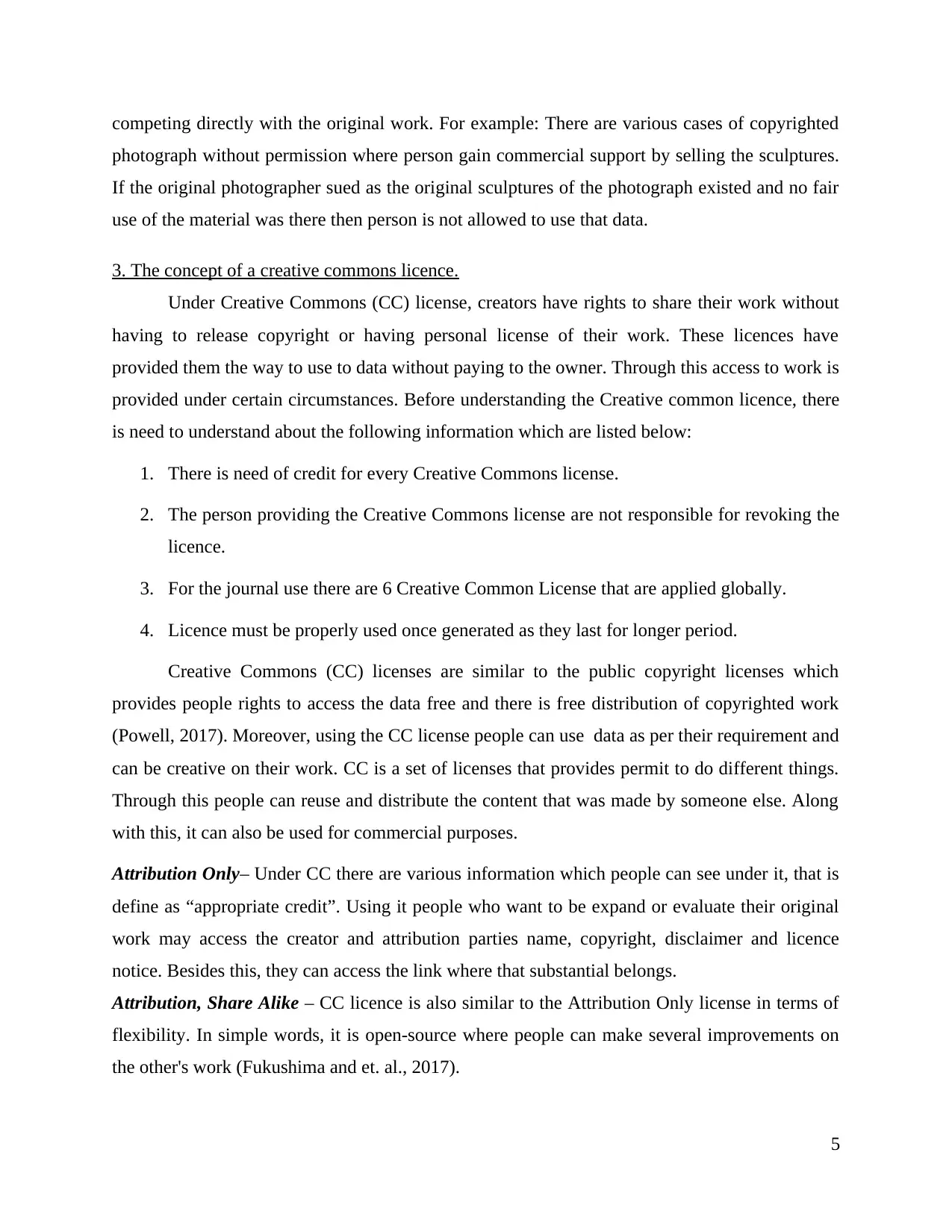
competing directly with the original work. For example: There are various cases of copyrighted
photograph without permission where person gain commercial support by selling the sculptures.
If the original photographer sued as the original sculptures of the photograph existed and no fair
use of the material was there then person is not allowed to use that data.
3. The concept of a creative commons licence.
Under Creative Commons (CC) license, creators have rights to share their work without
having to release copyright or having personal license of their work. These licences have
provided them the way to use to data without paying to the owner. Through this access to work is
provided under certain circumstances. Before understanding the Creative common licence, there
is need to understand about the following information which are listed below:
1. There is need of credit for every Creative Commons license.
2. The person providing the Creative Commons license are not responsible for revoking the
licence.
3. For the journal use there are 6 Creative Common License that are applied globally.
4. Licence must be properly used once generated as they last for longer period.
Creative Commons (CC) licenses are similar to the public copyright licenses which
provides people rights to access the data free and there is free distribution of copyrighted work
(Powell, 2017). Moreover, using the CC license people can use data as per their requirement and
can be creative on their work. CC is a set of licenses that provides permit to do different things.
Through this people can reuse and distribute the content that was made by someone else. Along
with this, it can also be used for commercial purposes.
Attribution Only– Under CC there are various information which people can see under it, that is
define as “appropriate credit”. Using it people who want to be expand or evaluate their original
work may access the creator and attribution parties name, copyright, disclaimer and licence
notice. Besides this, they can access the link where that substantial belongs.
Attribution, Share Alike – CC licence is also similar to the Attribution Only license in terms of
flexibility. In simple words, it is open-source where people can make several improvements on
the other's work (Fukushima and et. al., 2017).
5
photograph without permission where person gain commercial support by selling the sculptures.
If the original photographer sued as the original sculptures of the photograph existed and no fair
use of the material was there then person is not allowed to use that data.
3. The concept of a creative commons licence.
Under Creative Commons (CC) license, creators have rights to share their work without
having to release copyright or having personal license of their work. These licences have
provided them the way to use to data without paying to the owner. Through this access to work is
provided under certain circumstances. Before understanding the Creative common licence, there
is need to understand about the following information which are listed below:
1. There is need of credit for every Creative Commons license.
2. The person providing the Creative Commons license are not responsible for revoking the
licence.
3. For the journal use there are 6 Creative Common License that are applied globally.
4. Licence must be properly used once generated as they last for longer period.
Creative Commons (CC) licenses are similar to the public copyright licenses which
provides people rights to access the data free and there is free distribution of copyrighted work
(Powell, 2017). Moreover, using the CC license people can use data as per their requirement and
can be creative on their work. CC is a set of licenses that provides permit to do different things.
Through this people can reuse and distribute the content that was made by someone else. Along
with this, it can also be used for commercial purposes.
Attribution Only– Under CC there are various information which people can see under it, that is
define as “appropriate credit”. Using it people who want to be expand or evaluate their original
work may access the creator and attribution parties name, copyright, disclaimer and licence
notice. Besides this, they can access the link where that substantial belongs.
Attribution, Share Alike – CC licence is also similar to the Attribution Only license in terms of
flexibility. In simple words, it is open-source where people can make several improvements on
the other's work (Fukushima and et. al., 2017).
5
Paraphrase This Document
Need a fresh take? Get an instant paraphrase of this document with our AI Paraphraser
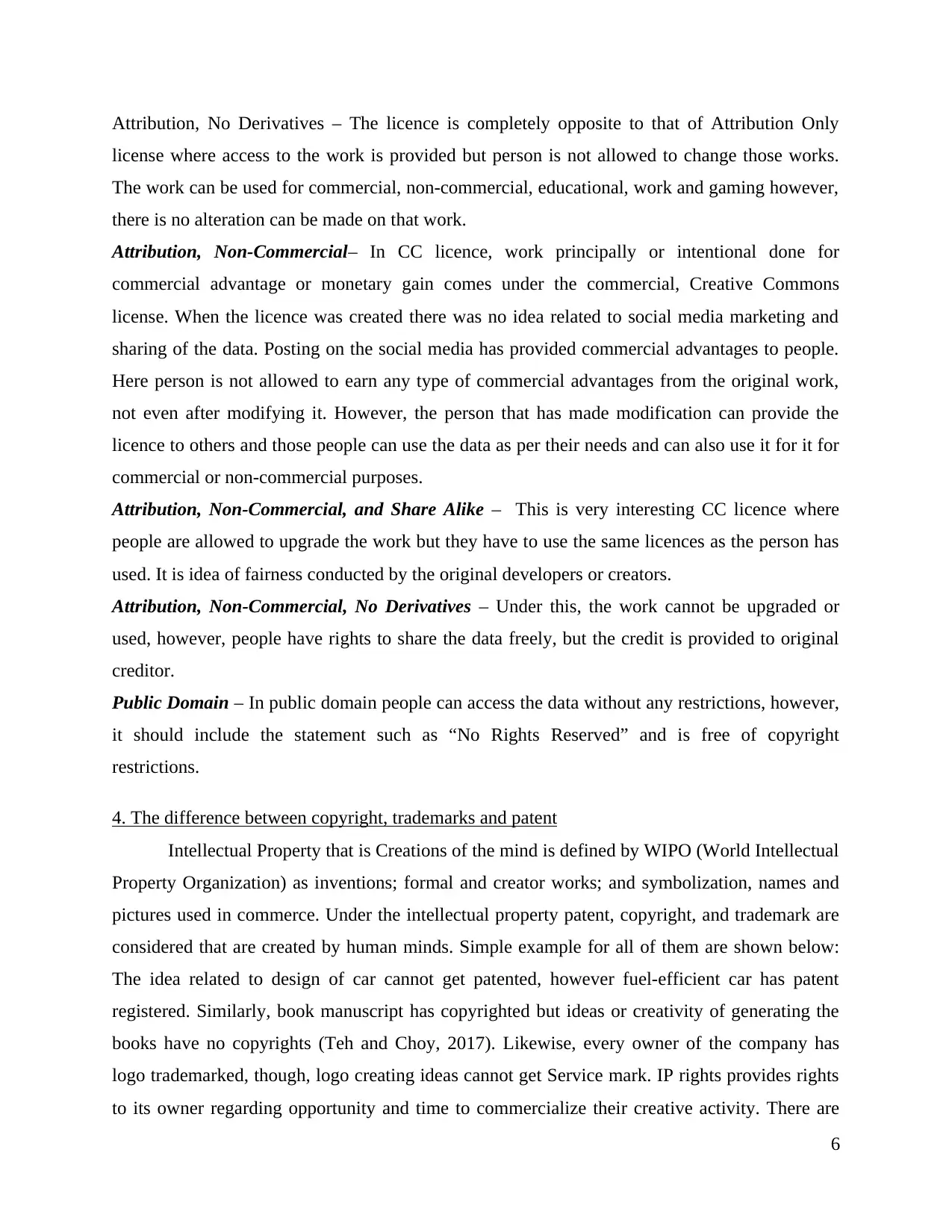
Attribution, No Derivatives – The licence is completely opposite to that of Attribution Only
license where access to the work is provided but person is not allowed to change those works.
The work can be used for commercial, non-commercial, educational, work and gaming however,
there is no alteration can be made on that work.
Attribution, Non-Commercial– In CC licence, work principally or intentional done for
commercial advantage or monetary gain comes under the commercial, Creative Commons
license. When the licence was created there was no idea related to social media marketing and
sharing of the data. Posting on the social media has provided commercial advantages to people.
Here person is not allowed to earn any type of commercial advantages from the original work,
not even after modifying it. However, the person that has made modification can provide the
licence to others and those people can use the data as per their needs and can also use it for it for
commercial or non-commercial purposes.
Attribution, Non-Commercial, and Share Alike – This is very interesting CC licence where
people are allowed to upgrade the work but they have to use the same licences as the person has
used. It is idea of fairness conducted by the original developers or creators.
Attribution, Non-Commercial, No Derivatives – Under this, the work cannot be upgraded or
used, however, people have rights to share the data freely, but the credit is provided to original
creditor.
Public Domain – In public domain people can access the data without any restrictions, however,
it should include the statement such as “No Rights Reserved” and is free of copyright
restrictions.
4. The difference between copyright, trademarks and patent
Intellectual Property that is Creations of the mind is defined by WIPO (World Intellectual
Property Organization) as inventions; formal and creator works; and symbolization, names and
pictures used in commerce. Under the intellectual property patent, copyright, and trademark are
considered that are created by human minds. Simple example for all of them are shown below:
The idea related to design of car cannot get patented, however fuel-efficient car has patent
registered. Similarly, book manuscript has copyrighted but ideas or creativity of generating the
books have no copyrights (Teh and Choy, 2017). Likewise, every owner of the company has
logo trademarked, though, logo creating ideas cannot get Service mark. IP rights provides rights
to its owner regarding opportunity and time to commercialize their creative activity. There are
6
license where access to the work is provided but person is not allowed to change those works.
The work can be used for commercial, non-commercial, educational, work and gaming however,
there is no alteration can be made on that work.
Attribution, Non-Commercial– In CC licence, work principally or intentional done for
commercial advantage or monetary gain comes under the commercial, Creative Commons
license. When the licence was created there was no idea related to social media marketing and
sharing of the data. Posting on the social media has provided commercial advantages to people.
Here person is not allowed to earn any type of commercial advantages from the original work,
not even after modifying it. However, the person that has made modification can provide the
licence to others and those people can use the data as per their needs and can also use it for it for
commercial or non-commercial purposes.
Attribution, Non-Commercial, and Share Alike – This is very interesting CC licence where
people are allowed to upgrade the work but they have to use the same licences as the person has
used. It is idea of fairness conducted by the original developers or creators.
Attribution, Non-Commercial, No Derivatives – Under this, the work cannot be upgraded or
used, however, people have rights to share the data freely, but the credit is provided to original
creditor.
Public Domain – In public domain people can access the data without any restrictions, however,
it should include the statement such as “No Rights Reserved” and is free of copyright
restrictions.
4. The difference between copyright, trademarks and patent
Intellectual Property that is Creations of the mind is defined by WIPO (World Intellectual
Property Organization) as inventions; formal and creator works; and symbolization, names and
pictures used in commerce. Under the intellectual property patent, copyright, and trademark are
considered that are created by human minds. Simple example for all of them are shown below:
The idea related to design of car cannot get patented, however fuel-efficient car has patent
registered. Similarly, book manuscript has copyrighted but ideas or creativity of generating the
books have no copyrights (Teh and Choy, 2017). Likewise, every owner of the company has
logo trademarked, though, logo creating ideas cannot get Service mark. IP rights provides rights
to its owner regarding opportunity and time to commercialize their creative activity. There are
6
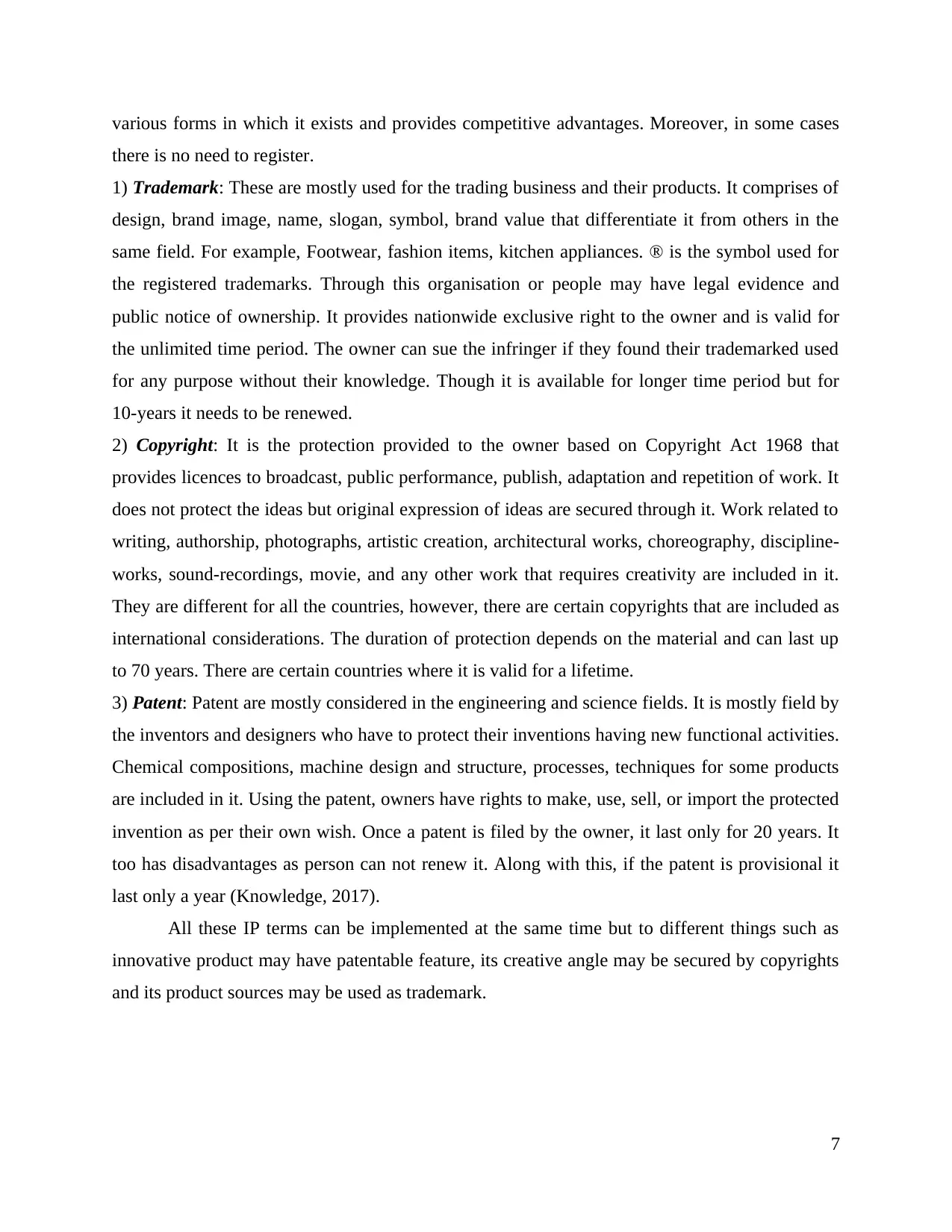
various forms in which it exists and provides competitive advantages. Moreover, in some cases
there is no need to register.
1) Trademark: These are mostly used for the trading business and their products. It comprises of
design, brand image, name, slogan, symbol, brand value that differentiate it from others in the
same field. For example, Footwear, fashion items, kitchen appliances. ® is the symbol used for
the registered trademarks. Through this organisation or people may have legal evidence and
public notice of ownership. It provides nationwide exclusive right to the owner and is valid for
the unlimited time period. The owner can sue the infringer if they found their trademarked used
for any purpose without their knowledge. Though it is available for longer time period but for
10-years it needs to be renewed.
2) Copyright: It is the protection provided to the owner based on Copyright Act 1968 that
provides licences to broadcast, public performance, publish, adaptation and repetition of work. It
does not protect the ideas but original expression of ideas are secured through it. Work related to
writing, authorship, photographs, artistic creation, architectural works, choreography, discipline-
works, sound-recordings, movie, and any other work that requires creativity are included in it.
They are different for all the countries, however, there are certain copyrights that are included as
international considerations. The duration of protection depends on the material and can last up
to 70 years. There are certain countries where it is valid for a lifetime.
3) Patent: Patent are mostly considered in the engineering and science fields. It is mostly field by
the inventors and designers who have to protect their inventions having new functional activities.
Chemical compositions, machine design and structure, processes, techniques for some products
are included in it. Using the patent, owners have rights to make, use, sell, or import the protected
invention as per their own wish. Once a patent is filed by the owner, it last only for 20 years. It
too has disadvantages as person can not renew it. Along with this, if the patent is provisional it
last only a year (Knowledge, 2017).
All these IP terms can be implemented at the same time but to different things such as
innovative product may have patentable feature, its creative angle may be secured by copyrights
and its product sources may be used as trademark.
7
there is no need to register.
1) Trademark: These are mostly used for the trading business and their products. It comprises of
design, brand image, name, slogan, symbol, brand value that differentiate it from others in the
same field. For example, Footwear, fashion items, kitchen appliances. ® is the symbol used for
the registered trademarks. Through this organisation or people may have legal evidence and
public notice of ownership. It provides nationwide exclusive right to the owner and is valid for
the unlimited time period. The owner can sue the infringer if they found their trademarked used
for any purpose without their knowledge. Though it is available for longer time period but for
10-years it needs to be renewed.
2) Copyright: It is the protection provided to the owner based on Copyright Act 1968 that
provides licences to broadcast, public performance, publish, adaptation and repetition of work. It
does not protect the ideas but original expression of ideas are secured through it. Work related to
writing, authorship, photographs, artistic creation, architectural works, choreography, discipline-
works, sound-recordings, movie, and any other work that requires creativity are included in it.
They are different for all the countries, however, there are certain copyrights that are included as
international considerations. The duration of protection depends on the material and can last up
to 70 years. There are certain countries where it is valid for a lifetime.
3) Patent: Patent are mostly considered in the engineering and science fields. It is mostly field by
the inventors and designers who have to protect their inventions having new functional activities.
Chemical compositions, machine design and structure, processes, techniques for some products
are included in it. Using the patent, owners have rights to make, use, sell, or import the protected
invention as per their own wish. Once a patent is filed by the owner, it last only for 20 years. It
too has disadvantages as person can not renew it. Along with this, if the patent is provisional it
last only a year (Knowledge, 2017).
All these IP terms can be implemented at the same time but to different things such as
innovative product may have patentable feature, its creative angle may be secured by copyrights
and its product sources may be used as trademark.
7

5. The difference between copyright and privacy.
Privacy is the part of copyright which is made to secure the personal data of the person.
The privacy policy outlines how Copyright Agency protects their data from getting exposed. The
act is based on the Privacy Act 1988 (Cth) (Privacy Act) and is carried under the obligation of
Australian Privacy Principles (APPs).
This privacy policy sets out:
It includes all the personal information that Copyright Agency collects and holds;
Moreover, the way they are collecting, using, revealing and storing the personal
information;
From the privacy policy, the purpose for which Copyright Agency collects your personal
information must be mentioned;
Along with this, person has rights to access their own personal information which is held
by Copyright Agency and they can make change or make modification under it
(Abeywickrama and Ovaska, 2017).
Besides this, it also deals with the data that are made under complain about a breach of
the APPs, the Copyright Agency have to deal with such a complaint and needs to provide
solution to the respective person.
However, as mentioned above, Copyright law provides exclusive rights to creators to
further evaluate and develop the product in given amount of time after that those products
become or are referred as public domain. The authorship has automatically the copyright
popularly known as Original Work of Authorship (OWA) that provides the owner actual rights to
prevent copying the products. Only tangible work that falls under creativity or creation are
considered as copyrights. In Australia, the copyrights are protected by the Australian Copyright
Act 1968 that is also applicable to national law throughout Australia. These laws are handled by
the Australian Copyright Council which non-profit independent organisation that are promoting
the benefits of copyrights for common goods.
8
Privacy is the part of copyright which is made to secure the personal data of the person.
The privacy policy outlines how Copyright Agency protects their data from getting exposed. The
act is based on the Privacy Act 1988 (Cth) (Privacy Act) and is carried under the obligation of
Australian Privacy Principles (APPs).
This privacy policy sets out:
It includes all the personal information that Copyright Agency collects and holds;
Moreover, the way they are collecting, using, revealing and storing the personal
information;
From the privacy policy, the purpose for which Copyright Agency collects your personal
information must be mentioned;
Along with this, person has rights to access their own personal information which is held
by Copyright Agency and they can make change or make modification under it
(Abeywickrama and Ovaska, 2017).
Besides this, it also deals with the data that are made under complain about a breach of
the APPs, the Copyright Agency have to deal with such a complaint and needs to provide
solution to the respective person.
However, as mentioned above, Copyright law provides exclusive rights to creators to
further evaluate and develop the product in given amount of time after that those products
become or are referred as public domain. The authorship has automatically the copyright
popularly known as Original Work of Authorship (OWA) that provides the owner actual rights to
prevent copying the products. Only tangible work that falls under creativity or creation are
considered as copyrights. In Australia, the copyrights are protected by the Australian Copyright
Act 1968 that is also applicable to national law throughout Australia. These laws are handled by
the Australian Copyright Council which non-profit independent organisation that are promoting
the benefits of copyrights for common goods.
8
Secure Best Marks with AI Grader
Need help grading? Try our AI Grader for instant feedback on your assignments.

6. Complaints related to data stolen based on Copyright Infringement Notification Requirement
for submitting the DMCA notice.
I am Paula, a small business owner that owns the Grow Management Consultancy and writes
monthly blog on all aspects of leadership and management. There was similar host company
(related to WHOIS information) that has outer boundary, one of my owned written content
which has copyright mentioned was copied by them. It was copied by them without my
permission on their servers. The same article you may access on my website to which we own
the exclusive copyrights, can be found at:
www.growmanagement.net.au/blog
and was written on April 2016. However, the unauthorized and infringing copy can be found at:
www.betterMC.net.au/weeklyblog
which was copied by them at 16 May 2016, 2 weeks after you originally produced by me.
The article was related to Leadership in the digital age, and this mail is about the official
notification under Section 512(c) of the Digital Millennium Copyright Act (”DMCA”). I
request you to remove the aforesaid edged material from your servers. It is a request to you that
strict action must be taken against the infringer and the data must be removed from the website.
Moreover, please remove the infringing material as-soon-as possible and further they should not
post any infringing material from their server .
Additionally, I would like your assistance to abide the laws, and block, remove or
disable access of that infringing materials when you receive this mail. I personally hope that
you will take action in deliberate speed to investigate and rectify ongoing copyright
infringement for being Australia law. If service providers do not investigate and remove or
disable the infringing material this immunity is lost. So, to maintain my immunity from
copyright infringement action you should take strict action as-soon-as you receive this mail.
I am providing this notice in good faith and with the reasonable belief that rights my
company owns are being infringed. Under penalty of perjury, I certify that the information
contained in the notification is both true and accurate, and I have the authority to act on behalf
of the owner of the copyright(s) involved. Please feel free if any doubt or discussion you need
to carry out.
9
for submitting the DMCA notice.
I am Paula, a small business owner that owns the Grow Management Consultancy and writes
monthly blog on all aspects of leadership and management. There was similar host company
(related to WHOIS information) that has outer boundary, one of my owned written content
which has copyright mentioned was copied by them. It was copied by them without my
permission on their servers. The same article you may access on my website to which we own
the exclusive copyrights, can be found at:
www.growmanagement.net.au/blog
and was written on April 2016. However, the unauthorized and infringing copy can be found at:
www.betterMC.net.au/weeklyblog
which was copied by them at 16 May 2016, 2 weeks after you originally produced by me.
The article was related to Leadership in the digital age, and this mail is about the official
notification under Section 512(c) of the Digital Millennium Copyright Act (”DMCA”). I
request you to remove the aforesaid edged material from your servers. It is a request to you that
strict action must be taken against the infringer and the data must be removed from the website.
Moreover, please remove the infringing material as-soon-as possible and further they should not
post any infringing material from their server .
Additionally, I would like your assistance to abide the laws, and block, remove or
disable access of that infringing materials when you receive this mail. I personally hope that
you will take action in deliberate speed to investigate and rectify ongoing copyright
infringement for being Australia law. If service providers do not investigate and remove or
disable the infringing material this immunity is lost. So, to maintain my immunity from
copyright infringement action you should take strict action as-soon-as you receive this mail.
I am providing this notice in good faith and with the reasonable belief that rights my
company owns are being infringed. Under penalty of perjury, I certify that the information
contained in the notification is both true and accurate, and I have the authority to act on behalf
of the owner of the copyright(s) involved. Please feel free if any doubt or discussion you need
to carry out.
9
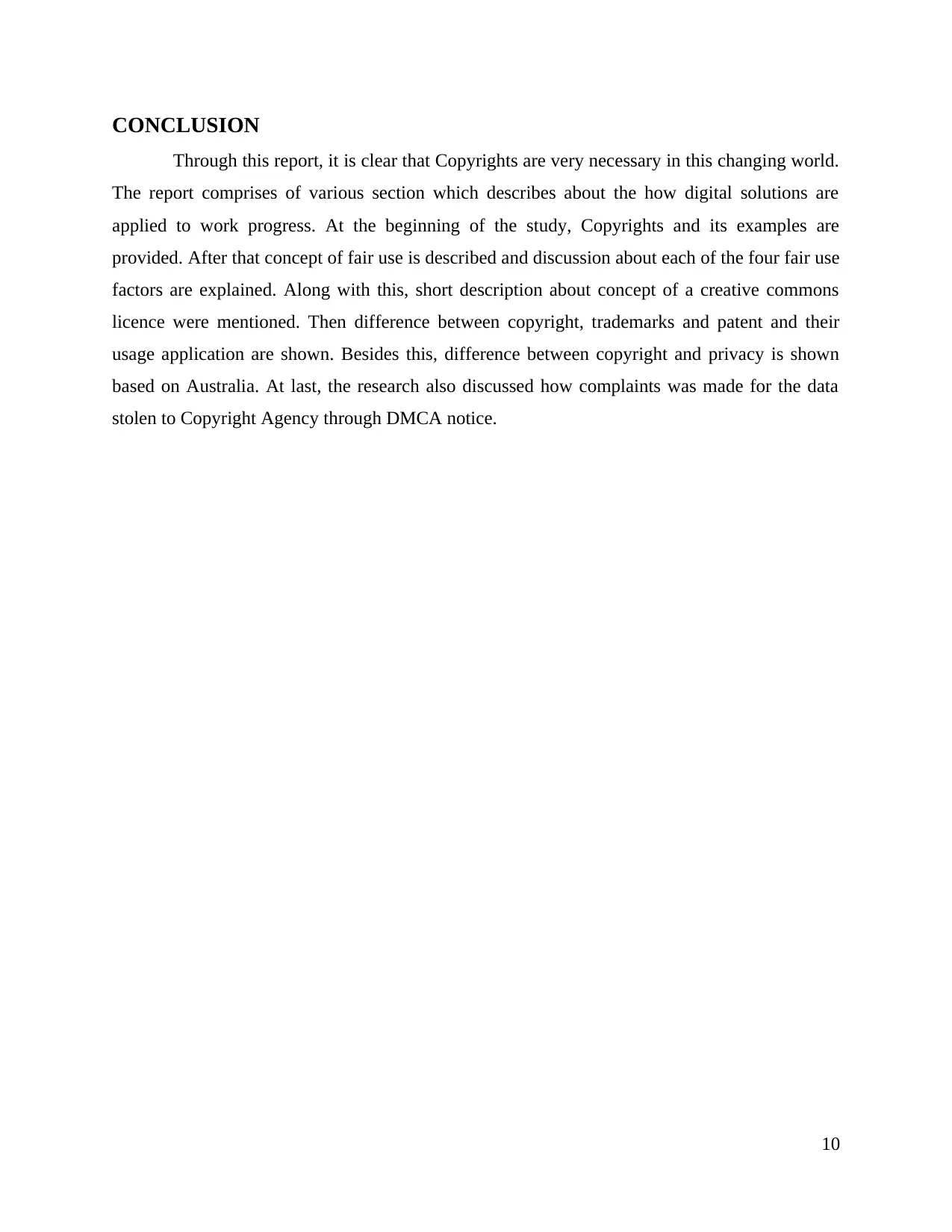
CONCLUSION
Through this report, it is clear that Copyrights are very necessary in this changing world.
The report comprises of various section which describes about the how digital solutions are
applied to work progress. At the beginning of the study, Copyrights and its examples are
provided. After that concept of fair use is described and discussion about each of the four fair use
factors are explained. Along with this, short description about concept of a creative commons
licence were mentioned. Then difference between copyright, trademarks and patent and their
usage application are shown. Besides this, difference between copyright and privacy is shown
based on Australia. At last, the research also discussed how complaints was made for the data
stolen to Copyright Agency through DMCA notice.
10
Through this report, it is clear that Copyrights are very necessary in this changing world.
The report comprises of various section which describes about the how digital solutions are
applied to work progress. At the beginning of the study, Copyrights and its examples are
provided. After that concept of fair use is described and discussion about each of the four fair use
factors are explained. Along with this, short description about concept of a creative commons
licence were mentioned. Then difference between copyright, trademarks and patent and their
usage application are shown. Besides this, difference between copyright and privacy is shown
based on Australia. At last, the research also discussed how complaints was made for the data
stolen to Copyright Agency through DMCA notice.
10

REFERENCES
Books and Journals
Abeywickrama, D. B. and Ovaska, E., 2017. A survey of autonomic computing methods in
digital service ecosystems. Service Oriented Computing and Applications. 11(1). pp.1-
31.
Dallmeier-Tiessen, S. and et. al., 2017. Connecting Data Publication to the Research Workflow:
A Preliminary Analysis. International Journal of Digital Curation. 12(1). pp.88-105.
Devaraju, A. and et. al., 2017, September. A Digital Repository for Physical Samples: Concepts,
Solutions and Management. In International Conference on Theory and Practice of
Digital Libraries (pp. 74-85). Springer, Cham.
Finelli, C. J. and Johnson, A. W., 2017, April. Work in progress: Flipping the circuits classroom:
The impact of pre-class reading and in-class active learning on student and instructor.
In Global Engineering Education Conference (EDUCON), 2017 IEEE (pp. 437-440).
IEEE.
Fukushima, Y. and et. al., 2017. Education and capacity building with research: a possible case
for Future Earth. International Journal of Sustainability in Higher Education. 18(2).
pp.263-276.
Gabbrielli, F. and et. al., 2017. Perspectives in Digital Health and Precision Medicine. In New
Perspectives in Medical Records (pp. 91-102). Springer International Publishing.
Kaivo-oja, J., Roth, S. and Westerlund, L., 2017. Futures of robotics. Human work in digital
transformation. International Journal of Technology Management. 73(4). pp.176-205.
Knowledge, S., 2017. Accessing and Securing Conceptual and Symbolic Knowledge Required
for Digital Era Work. The Impact of Digitalization in the Workplace: An Educational
View. 21. p.197.
Newhouse, C. P., 2017. STEM the Boredom: Engage Students in the Australian Curriculum
Using ICT with Problem-Based Learning and Assessment. Journal of Science Education
and Technology. 26(1). pp.44-57.
Powell, G., 2017. Training Pre-Service Teachers in the Use of Challenge-Based Learning and
Sandbox Experiences as Practical Applications of Digital Technology for Authentic
Learning in the Twenty-First Century Classroom. In Handbook on Digital Learning for
K-12 Schools (pp. 381-396). Springer International Publishing.
Simkin, P., Hanson, L. and Ancheta, R., 2017. The labor progress handbook: early interventions
to prevent and treat dystocia. John Wiley & Sons.
Teh, G. B. and Choy, S. C. eds., 2017. Empowering 21st Century Learners Through Holistic and
Enterprising Learning: Selected Papers from Tunku Abdul Rahman University College
International Conference 2016. Springer.
Trevallion, D. and Sellars, M., 2018. Technology Education and the Australian Curriculum. In
Numeracy in Authentic Contexts (pp. 405-422). Springer, Singapore.
Online
Growing Your Business with the Domino Digital Solutions Program. 2017. [Online]. Available
from <https://www.dominodigitalprinting.com/digitalsolutionsprogram>.
11
Books and Journals
Abeywickrama, D. B. and Ovaska, E., 2017. A survey of autonomic computing methods in
digital service ecosystems. Service Oriented Computing and Applications. 11(1). pp.1-
31.
Dallmeier-Tiessen, S. and et. al., 2017. Connecting Data Publication to the Research Workflow:
A Preliminary Analysis. International Journal of Digital Curation. 12(1). pp.88-105.
Devaraju, A. and et. al., 2017, September. A Digital Repository for Physical Samples: Concepts,
Solutions and Management. In International Conference on Theory and Practice of
Digital Libraries (pp. 74-85). Springer, Cham.
Finelli, C. J. and Johnson, A. W., 2017, April. Work in progress: Flipping the circuits classroom:
The impact of pre-class reading and in-class active learning on student and instructor.
In Global Engineering Education Conference (EDUCON), 2017 IEEE (pp. 437-440).
IEEE.
Fukushima, Y. and et. al., 2017. Education and capacity building with research: a possible case
for Future Earth. International Journal of Sustainability in Higher Education. 18(2).
pp.263-276.
Gabbrielli, F. and et. al., 2017. Perspectives in Digital Health and Precision Medicine. In New
Perspectives in Medical Records (pp. 91-102). Springer International Publishing.
Kaivo-oja, J., Roth, S. and Westerlund, L., 2017. Futures of robotics. Human work in digital
transformation. International Journal of Technology Management. 73(4). pp.176-205.
Knowledge, S., 2017. Accessing and Securing Conceptual and Symbolic Knowledge Required
for Digital Era Work. The Impact of Digitalization in the Workplace: An Educational
View. 21. p.197.
Newhouse, C. P., 2017. STEM the Boredom: Engage Students in the Australian Curriculum
Using ICT with Problem-Based Learning and Assessment. Journal of Science Education
and Technology. 26(1). pp.44-57.
Powell, G., 2017. Training Pre-Service Teachers in the Use of Challenge-Based Learning and
Sandbox Experiences as Practical Applications of Digital Technology for Authentic
Learning in the Twenty-First Century Classroom. In Handbook on Digital Learning for
K-12 Schools (pp. 381-396). Springer International Publishing.
Simkin, P., Hanson, L. and Ancheta, R., 2017. The labor progress handbook: early interventions
to prevent and treat dystocia. John Wiley & Sons.
Teh, G. B. and Choy, S. C. eds., 2017. Empowering 21st Century Learners Through Holistic and
Enterprising Learning: Selected Papers from Tunku Abdul Rahman University College
International Conference 2016. Springer.
Trevallion, D. and Sellars, M., 2018. Technology Education and the Australian Curriculum. In
Numeracy in Authentic Contexts (pp. 405-422). Springer, Singapore.
Online
Growing Your Business with the Domino Digital Solutions Program. 2017. [Online]. Available
from <https://www.dominodigitalprinting.com/digitalsolutionsprogram>.
11
1 out of 13
Related Documents
Your All-in-One AI-Powered Toolkit for Academic Success.
+13062052269
info@desklib.com
Available 24*7 on WhatsApp / Email
![[object Object]](/_next/static/media/star-bottom.7253800d.svg)
Unlock your academic potential
© 2024 | Zucol Services PVT LTD | All rights reserved.





